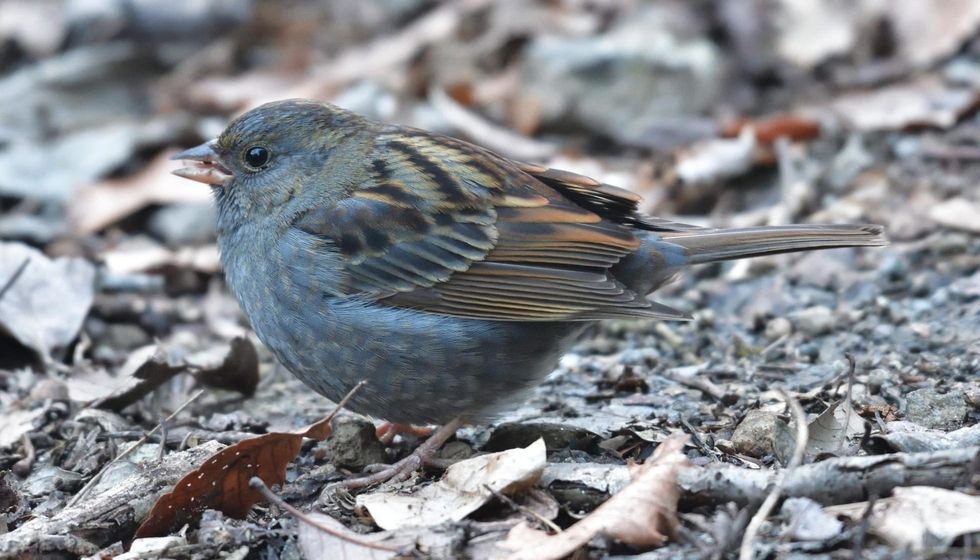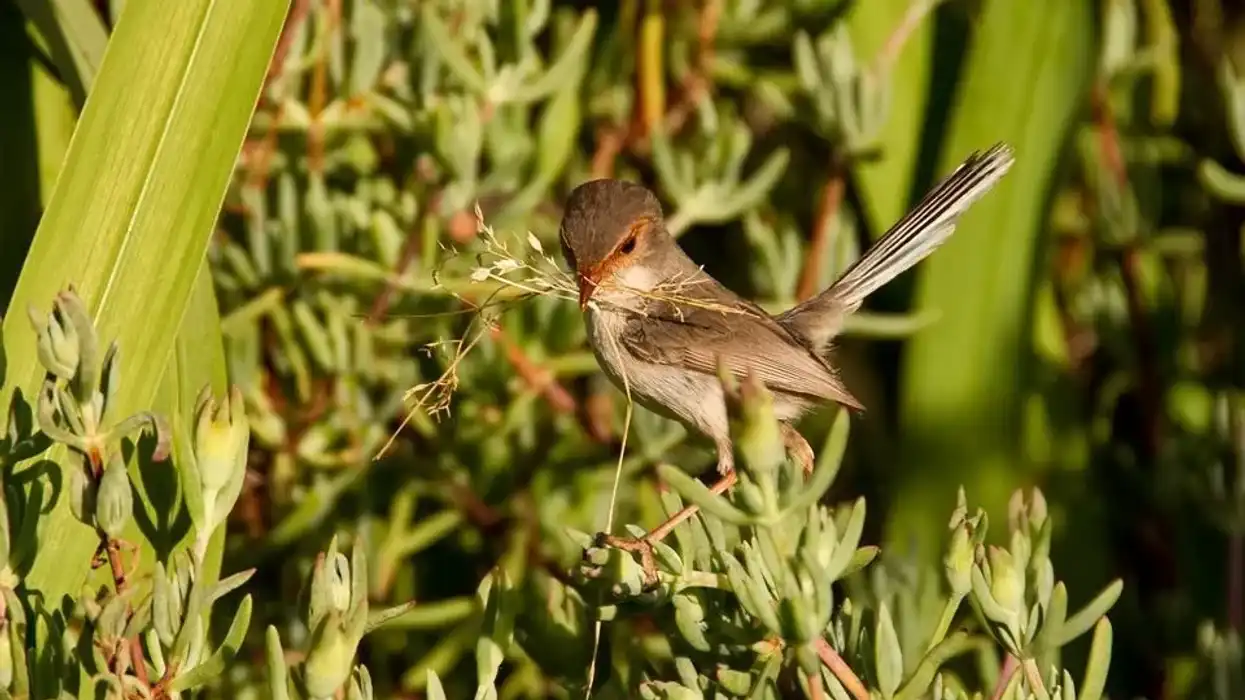The grey bunting (Emberiza variabilis) is a passerine bird from the family Emberizidae that consists of seed-eating birds with a conical, stubby beak. This bird species population is native to Asia, especially in northern Japan, and southern Kamchatka, Kuril, and Sakhalin Islands of Russia.
The grey bunting habitat distribution is observed in bamboo, deciduous or coniferous forests at an elevation between 3,608-5905 ft (1,100-1,800 m). During the winter, the northern Japan population of these birds migrates to the southern region.
The breeding season of this bird species begins in June and peaks in July.
Their nests are made from leaves, moss, and grass and are built close to or on the ground and the female lays two to five eggs and incubates them for 12 days. The male also participates in feeding the chicks.
The male grey bunting makes a 'ho-I ci ci ci' at the beginning of the breeding season. Otherwise, this bird species usually gives out a sharp 'zhiik' call. In addition, the global range of these birds is stable and the IUCN has declared the status of Least Concern.
If you enjoy reading about tiny passerine birds, check out the painted bunting and snow bunting.
Grey Bunting Interesting Facts
What type of animal is a grey bunting?
The grey bunting is a passerine bird species from the seed-eater family of Emberizidae.
What class of animal does a grey bunting belong to?
The grey bunting is a bird and belongs to the class of Aves.
How many grey buntings are there in the world?
The range of the number of grey bunting birds is unknown. However, their population is stable and found commonly across Russia and northern Japan.
Where does a grey bunting live?
The grey bunting bird subspecies are found across Russia and Japan. The E. v. variabilis is found in the Kamchatka, Sakhalin, and Kuril Islands of Russia, and in Hokkaido and Honshu in Japan.
During the winter, they migrate to southern Shikoku, Ryukyu, Kyushu, and Shikoku Islands of Japan, and rarely, in South Korea. The E. v. musica subspecies is the one found in Kamchatka.
What is a grey bunting's habitat?
The grey bunting (Emberiza variabilis) bird species habitat includes deciduous, bamboo, and coniferous forests, almost like the short-billed dowitcher. In the winter, they move to regions with thick forests and marsh reedbeds, where they can be spotted near streams among the undergrowth.
Who do grey buntings live with?
This bird species is spotted in pairs even during the non-breeding season. Sometimes, they also move in flocks of five to six when migrating from the north to southern Japan.
How long does a grey bunting live?
The lifespan of these birds is around six years.
How do they reproduce?
The grey bunting (Emberiza variabilis) breeding season takes off in June and peaks during July. The male birds are heard making a 'ho-I ci ci ci' sound at the beginning of the season.
This species build their nest on around 3 ft (1 m) from the ground, usually low in a bush or among a tussock of grass. Their nest is cup-shaped and made using mass, grass, and leaves with an inner lining of fine grass, rootlets, or tendrils.
The female has a clutch size of two to five whitish eggs with dark scribbles and the female bird incubates the eggs for around 12 days.
After the chicks hatch, the male also gets involved in feeding and caring for them. The fledgling stage lasts for 11-15 days, after which the chicks leave the nest.
What is their conservation status?
The population range of these birds has shown a stable trend and the IUCN has given the grey bunting a conservation status of Least Concern.
Grey Bunting Fun Facts
What do grey buntings look like?
These birds show minor differences in their breeding and non-breeding plumage like the European starling. The breeding male species has a pale, slate-grey back, head, and underparts with dark streaks on the back and wings.
The wings are primarily grey but darker towards the center of the upper wing coverts while the flight feathers are dark grey-brown. The breeding male also shows darker lores on the head and the tail is dark brown with faded blue-grey edges.
During the non-breeding season, the male feathers are more brown-buff with a similar shade on the fringes of new feathers. Similar colored lateral stripes appear on the head with a prominent crown strip and faded supercilium.
The female has a similar plumage as the non-breeding male. However, the neck, breast, and underparts have white hues with dark streaks. Both birds have pink feet, a faded black upper beak, pinkish lower beak, and dark brown eyes.

How cute are they?
The grey bunting (Emberiza variabilis) is a short, stubby bird with a large, rounded breast, making them look really cute.
How do they communicate?
There are no records on how the grey bunting birds communicate.
How big is a grey bunting?
These birds have a body length between 5.9-6.5 in (15-16.5 cm), which is about the same length as the vesper sparrow, but half the length of the northern shrike.
How fast can a grey bunting fly?
Although the exact flight speed is not recorded, the grey bunting flies fast with quick wing beats, alternated by pulling the wings to the side and gliding.
How much does a grey bunting weigh?
The average grey bunting (Emberiza variabilis) weight is around 0.7-1 oz (21-29 g).
What are the male and female names of the species?
Male and female grey bunting birds do not have separate names.
What would you call a baby grey bunting?
The babies of this bird species are called a chick or juvenile.
What do they eat?
The diet of these birds mainly consists of seeds, but they do eat berries, fruits, and insects. They usually eat insects during the breeding season.
Are they dangerous?
No, the grey bunting is neither aggressive nor dangerous.
Would they make a good pet?
The grey bunting bird is a wild species that lives in deciduous or coniferous forests, and keeping them as house pets would not be advised.
Did you know...
The grey bunting wingspan is 9 in (22.7 cm).
What does the grey bunting's call sound like?
The grey bunting voices a series of sharp 'zhiik' notes, and at the beginning of the breeding season, the male sings a 'ho-I ci ci ci' song. Their regular song is a flute-like 'houee-tseewee-tseewee' sound. Sometimes, a slow and fast song version like 'ksuuu tsisisisisis' can be heard.
Where do grey buntings nest?
The grey bunting prefers building its nest on the ground and no more than 3.28 ft (1 m) above the groun. They usually choose spots in tussocks of grass, or at the base of bushes and shrubs.
Here at Kidadl, we have carefully created lots of interesting family-friendly animal facts for everyone to discover! Learn more about some other birds from our carrion crow facts and chipping sparrow facts pages.
You can even occupy yourself at home by coloring in one of our free printable grey bunting coloring pages.









